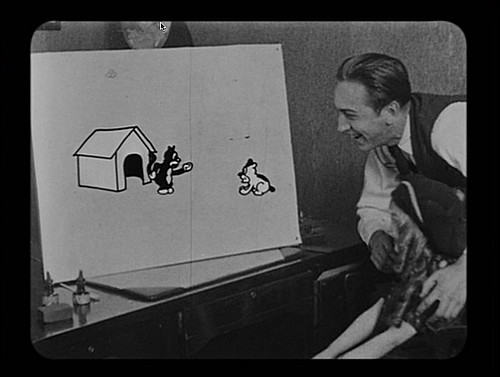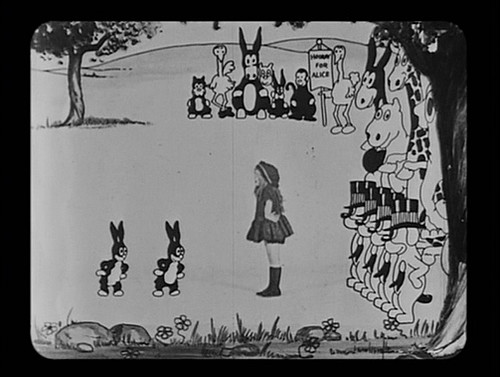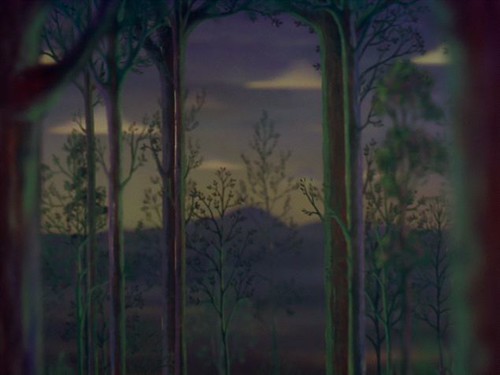More cartoons on the mind – bumping this post from 2011 to the top of the queue.[Some time ago] ago when I blogged about Animation and the Sentient Text I speculated
about object-oriented ontology in the age of animation: Is there a connection? Animated films have been with us since the early 1920s, and animation itself extends back into the 19th Century, with flip books, kinoscopes and such. In its cinematic guise animation has been aware of itself and its tech and has depicted that in many and various of its works. From this it follows that animation is aware of the apparent ontological difference between its materials, static images, and its effects, living beings (and others) on the screen and into the minds of viewers.
Let me continue that speculation.
Early in his career Walt Disney did a series of films known as the Alice films. They were short subjects in which a girl named Alice—who owes little to Lewis Carroll’s Alice that I can see—does this that and the other. Alice, however, is a live action girl, while the world in which she does this that and the other is an animated one. Here’s a frame grab:
That’s Walt Disney standing over her shoulder and, of course, an animated scene in front of her. In this shot we see an animated mouse attempt to annoy a live action cat:
He doesn’t succeed. Finally, in this shot, Alice has entered fully into the animated world:
My knowledge of animation’s early years is fairly spotty, so I have little sense of common this trope was: the mixture of live action and animation. It was certainly there in some of Winsor McCays early shorts, e.g. Little Nemo and Gertie the Dinosaur:
And, of course, it has come and gone throughout the history of cartoons, for example, Disney’s Three Caballeros (1944), and Zemeckis’s Who Framed Roger Rabbit (1988).
We could even include Cameron’s Avatar in the group, though it uses CGI animation rather than tradition cel animation. I’ve heard that Cameron himself objects to such a characterization, but the bloody fact of the matter is that Avatar is NOT a live-action film in the traditional sense of such things. The CGI is far too extensive and, shall we say, invasive, to be cordoned off as ‘special effects’. Still more deeply, as Latour has argued in "An Attempt at a 'Compositionist Manifesto'", the film inverts “the relationship between the original and the copy” and redefines “what it means to have a body, a mind, and a world.” It’s as though Marshall McLuhan has become reincarnated in a metaphysical cartoon where medium and message are one.
As a medium, and in radical distinction from live-action film, animation assigns no special privilege to humans over animals, nor, indeed, to living things over inanimate things. Live action film depends on moving actors. Producing films in genres that require movement from ‘unusual beings’, genres such as fantasy and science fiction, requires expensive special effects. Cartoons are different. Anything that can be drawn can be animated. Animals, trees, cars, rocks, pots and pans, all can be drawn to dance and talk without special privilege. Humans may or may not be present in a cartoon. The animator’s pencil is the ultimate ontology flattener.
Animation IS the medium of object-oriented ontology.
And Disney’s Fantasia is one of its masterworks. It is, as I’ve argued, a cosmology, and therefore an ontology. Disney parades the things of the world before us, almost daring to objectify the universe itself. Humans are assigned no privilege in this cosmology. We are there, but it is not about us.
By the strictest accounting, humans appear in only two of the eight segments, The Sorcerer’s Apprentice (the Sorcerer) and the final segment, Ave Maria (the procession of pilgrims). The former centers, of course, on the apprentice, not the Sorcerer, and the apprentice is Mickey Mouse, one of those ‘funny animals’ that figures in so many cartoons. A human, in some ways, but not a human. An ambiguous figure. In the Ave Maria segment the pilgrims are so small that they have no differentiated parts; each is just a moving robe pushing a lighted candle.
Very little would change if they were dropped from view, so small are they. Indeed, halfway through the segment they ARE dropped from view:
It’s as though they’re present precisely to AFFIRM that it is not about us. It is one thing to have a long segment like The Rite of Spring that does not include humans, though it IS teeming with life. In the Ave Maria humans are there; then they are, deliberately, gone. And still the film continues.
IT IS NOT ABOUT US
Whatever Disney thought he was doing, he did in fact present us, the audience, the gobsmacked viewers, with a vision of the entire cosmos in which we DO play a role, but not THE role. For perhaps the first time in human history it was possible to see and dwell in, if only fictively, the whole cosmos within the compass of two hours.
As far as I know, Disney thought he was doing two things: 1) presenting classical music to the masses, and 2) showcasing this new medium. He did both, though he was more successful with the second than the first. Given the nature of the medium, is it any accident that this showcase should situate humans IN the universe rather than at the center, or even at the top?
Strange, is it not, to think of Walt Disney as once again the avant-garde figure he was regarded in the late 1930s. But I talk not about Disney alone, but about the medium in which he has been such an important figure. The medium persists, alas, in search of the respect it lost after World War II, which consigned it to the kiddie korner, at least in the USofA, if not Japan.
Japan is a different story, one I’m not going to attempt to recount here. I note only, and following Tyler Cowan, that, on the face of it, Cameron’s Pandora owes a great deal to the worlds Miyazaki created in Princess Mononoke and Castle in the Sky.
More later.





No comments:
Post a Comment